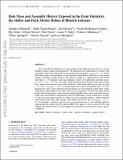Halo mass and assembly history exposed in the faint outskirts: the stellar and dark matter haloes of Illustris galaxies
Author(s)
Pillepich, Annalisa; Vogelsberger, Mark; Deason, Alis; Rodriguez-Gomez, Vicente; Genel, Shy; Nelson, Dylan; Torrey, Paul; Sales, Laura V.; Marinacci, Federico; Springel, Volker; Sijacki, Debora; Hernquist, Lars; ... Show more Show less
DownloadVogelsberger_Halo mass.pdf (11.60Mb)
OPEN_ACCESS_POLICY
Open Access Policy
Creative Commons Attribution-Noncommercial-Share Alike
Terms of use
Metadata
Show full item recordAbstract
We use the Illustris simulations to gain insight into the build-up of the outer, low-surface brightness regions which surround galaxies. We characterize the stellar haloes by means of the logarithmic slope of the spherically averaged stellar density profiles, α[subscript STARS] at z = 0, and we relate these slopes to the properties of the underlying dark matter (DM) haloes, their central galaxies, and their assembly histories. We analyse a sample of ∼5000 galaxies resolved with more than 5 × 10[superscript 4] particles each, and spanning a variety of morphologies and halo masses (3 × 10[superscript 11] ≤ M[subscript vir] ≲ 10[superscript 14]M[subscript ⊙]). We find a strong trend between stellar halo slope and total halo mass, where more massive objects have shallower stellar haloes than the less massive ones (−5.5 ± 0.5 < α[subscript STARS] < −3.5 ± 0.2 in the studied mass range). At fixed halo mass, we show that disc-like, blue, young, and more massive galaxies are surrounded by significantly steeper stellar haloes than elliptical, red, older, and less massive galaxies. Overall, the stellar density profiles fall off much more steeply than the underlying DM, and no clear trend holds between stellar slope and DM halo concentration. However, DM haloes which formed more recently, or which accreted larger fractions of stellar mass from infalling satellites, exhibit shallower stellar haloes than their older analogues with similar masses, by up to Δα[subscript STARS] ~ 0.5–0.7. Our findings, combined with the most recent measurements of the strikingly different stellar power-law indices for M31 and the Milky Way, appear to favour a massive M31, and a Milky Way characterized by a much quieter accretion history over the past 10 Gyr than its companion.
Date issued
2014-08Department
Massachusetts Institute of Technology. Department of Physics; MIT Kavli Institute for Astrophysics and Space ResearchJournal
Monthly Notices of the Royal Astronomical Society
Publisher
Oxford University Press
Citation
Pillepich, A., M. Vogelsberger, A. Deason, V. Rodriguez-Gomez, S. Genel, D. Nelson, P. Torrey, et al. “Halo Mass and Assembly History Exposed in the Faint Outskirts: The Stellar and Dark Matter Haloes of Illustris Galaxies.” Monthly Notices of the Royal Astronomical Society 444, no. 1 (August 14, 2014): 237–49.
Version: Author's final manuscript
ISSN
0035-8711
1365-2966